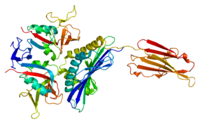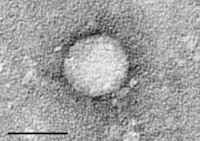
Lectin Fingerprinting Distinguishes Antibody Neutralization in SARS-CoV-2
Sign Up to like & getrecommendations! Published in 2023 at "ACS Central Science"
DOI: 10.1021/acscentsci.2c01471
Abstract: Enveloped viruses co-opt host glycosylation pathways to decorate their surface proteins. As viruses evolve, emerging strains can modify their glycosylation patterns to influence host interactions and subvert immune recognition. Still, changes in viral glycosylation or… read more here.
Keywords: antibody neutralization; lectin fingerprinting; glycosylation; immune recognition ... See more keywords

Immune recognition of microbial metabolites
Sign Up to like & getrecommendations! Published in 2019 at "Nature Reviews Immunology"
DOI: 10.1038/s41577-019-0252-2
Abstract: Mucosal immunology research continues its fascination with microbial metabolites. In 2019, researchers uncovered extended functions for microbial metabolites in immunity, deepening our understanding of the regulation and function of metabolite-reactive immune cells, and revealed the… read more here.
Keywords: microbial metabolites; immune recognition; recognition microbial; immune cells ... See more keywords

From the banal to the bizarre: unravelling immune recognition and response to microbial lipids.
Sign Up to like & getrecommendations! Published in 2022 at "Chemical communications"
DOI: 10.1039/d1cc06003a
Abstract: Microbes produce a rich array of lipidic species that through their location in the cell wall and ability to mingle with host lipids represent a privileged class of immune-active molecules. Lipid-sensing immunity recognizes microbial lipids… read more here.
Keywords: immune recognition; microbial lipids; unravelling immune; recognition ... See more keywords

A blast fungus zinc-finger fold effector binds to a hydrophobic pocket in host Exo70 proteins to modulate immune recognition in rice
Sign Up to like & getrecommendations! Published in 2022 at "Proceedings of the National Academy of Sciences of the United States of America"
DOI: 10.1073/pnas.2210559119
Abstract: Significance Plant diseases destroy ∼20 to 30% of annual crop production, contributing to global food insecurity. Discovering how pathogen effectors target host proteins to promote virulence is essential for understanding pathogenesis and can be used… read more here.
Keywords: recognition; blast; rice; effector ... See more keywords

Genetic diversity of Staphylococcus aureus wall teichoic acid glycosyltransferases affects immune recognition
Sign Up to like & getrecommendations! Published in 2022 at "Microbial Genomics"
DOI: 10.1099/mgen.0.000902
Abstract: Staphylococcus aureus (S. aureus) is a leading cause of skin and soft tissue infections and (hospital-acquired) systemic infections. Wall teichoic acids (WTAs) are cell wall-anchored glycopolymers that are important for S. aureus nasal colonization, endocarditis,… read more here.
Keywords: recognition; genetic diversity; staphylococcus aureus; wall teichoic ... See more keywords

Robust Feature Selection With LSTM Recurrent Neural Networks for Artificial Immune Recognition System
Sign Up to like & getrecommendations! Published in 2019 at "IEEE Access"
DOI: 10.1109/access.2019.2900118
Abstract: Stability and robustness of feature selection techniques have great importance in the high dimensional and small sample data. The neglected subject in the feature selection is solving the instability problem. Therefore, an ensemble gene selection… read more here.
Keywords: artificial immune; recognition system; feature selection; selection ... See more keywords

QSAR analysis of immune recognition for triazine herbicides based on immunoassay data for polyclonal and monoclonal antibodies
Sign Up to like & getrecommendations! Published in 2019 at "PLoS ONE"
DOI: 10.1371/journal.pone.0214879
Abstract: A common task in the immunodetection of structurally close compounds is to analyze the selectivity of immune recognition; it is required to understand the regularities of immune recognition and to elucidate the basic structural elements… read more here.
Keywords: analysis immune; qsar analysis; monoclonal antibodies; immune recognition ... See more keywords

Innate Immune Recognition: Implications for the Interaction of Francisella tularensis with the Host Immune System
Sign Up to like & getrecommendations! Published in 2017 at "Frontiers in Cellular and Infection Microbiology"
DOI: 10.3389/fcimb.2017.00446
Abstract: The intracellular bacterial pathogen Francisella tularensis causes serious infectious disease in humans and animals. Moreover, F. tularensis, a highly infectious pathogen, poses a major concern for the public as a bacterium classified under Category A… read more here.
Keywords: innate immune; francisella tularensis; immune recognition;

Innate Immune Recognition: An Issue More Complex Than Expected
Sign Up to like & getrecommendations! Published in 2019 at "Frontiers in Cellular and Infection Microbiology"
DOI: 10.3389/fcimb.2019.00241
Abstract: Primary interaction of an intracellular bacterium with its host cell is initiated by activation of multiple signaling pathways in response to bacterium recognition itself or as cellular responses to stress induced by the bacterium. The… read more here.
Keywords: bacterium; recognition issue; immune recognition; recognition ... See more keywords

The HHV-6A Proteins U20 and U21 Target NKG2D Ligands to Escape Immune Recognition
Sign Up to like & getrecommendations! Published in 2021 at "Frontiers in Immunology"
DOI: 10.3389/fimmu.2021.714799
Abstract: The coevolution of the human immune system and herpesviruses led to the emergence and diversification of both cellular danger molecules recognized by immune cells on the one hand and viral countermeasures that prevent the expression… read more here.
Keywords: nkg2d ligands; immune recognition; recognition; escape immune ... See more keywords

Innate immune recognition and modulation in hepatitis D virus infection
Sign Up to like & getrecommendations! Published in 2020 at "World Journal of Gastroenterology"
DOI: 10.3748/wjg.v26.i21.2781
Abstract: Hepatitis D virus (HDV) is a global health threat with more than 15 million humans affected. Current treatment options are largely unsatisfactory leaving chronically infected humans at high risk to develop liver cirrhosis and hepatocellular… read more here.
Keywords: immune recognition; hepatitis virus; hdv; innate immune ... See more keywords